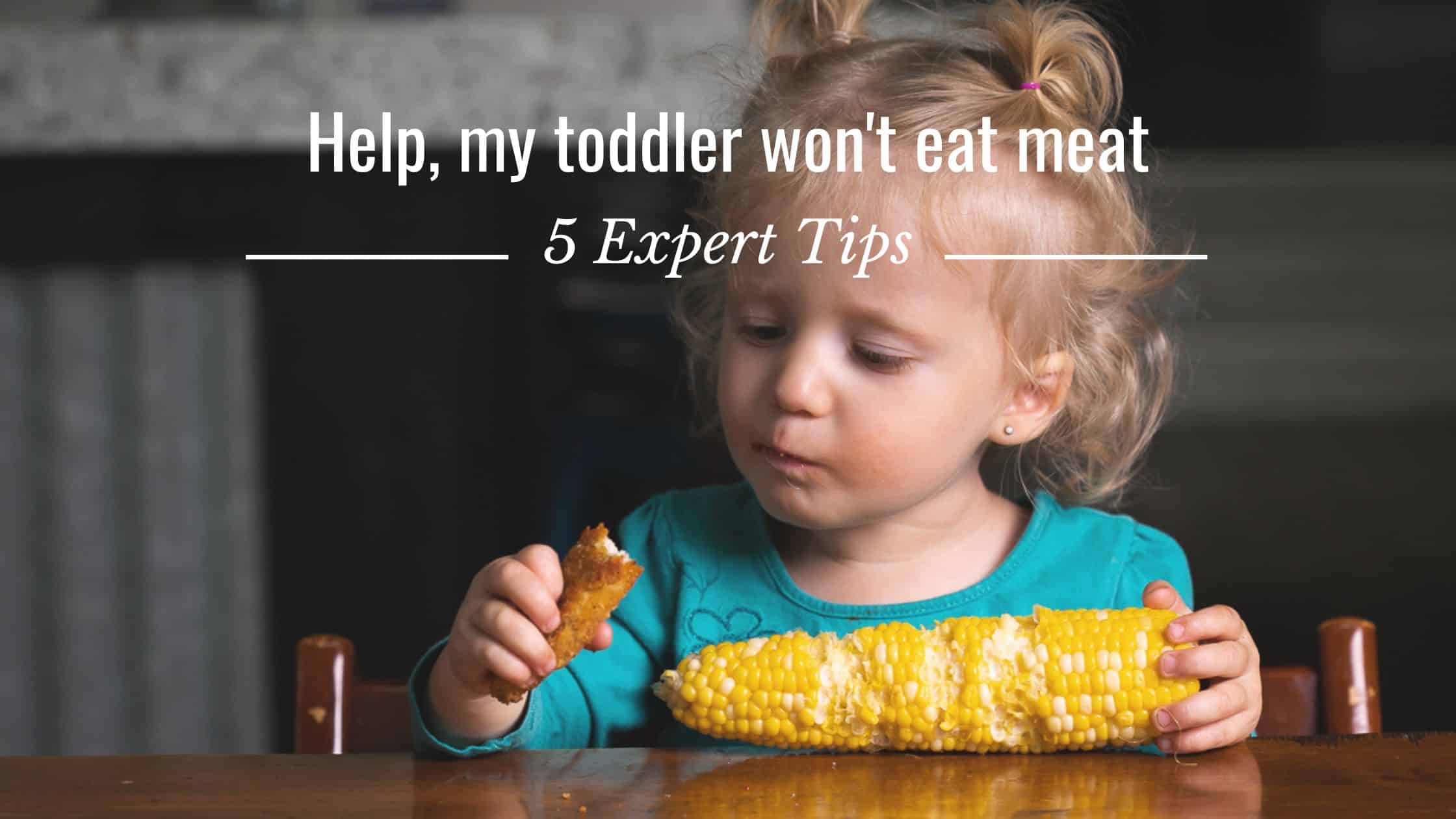
Help, my Toddler Won’t Eat Meat: 5 Expert Tips
Why don’t kids like meat, and what nutrients might they miss? This blog shares tips from a dietitian about how to get a toddler or older child to eat meat & other sources of essential nutrients like iron.
One of the most common concerns I hear from meat-eating parents of toddlers or preschoolers is that their child won’t eat meat. Beyond maybe the odd chicken nugget, pepperoni stick or slice of deli ham! And some kids won’t even go near those.
If this is your child – you’re not alone. And you are probably worried your kid isn’t getting enough protein and nutrients without meat. I understand! As a mother, I had a picky eater who ended up with low iron levels.
In this post, we’ll review essential nutrients found in meat, alternative sources, and five tips to encourage your toddler (or an older child) to eat meat.
Why don’t kids like meat?
1) The taste of meat unappealing to kids
Kids tend not to like meat because it often has a strong flavour. Depending on how it’s cooked – which we will talk about!
In contrast to meat flavour – kids naturally prefer sweet-flavoured foods. Because sweet indicates that the food is an easy source of quick energy, this is one reason your little one likes to live on crackers, bread and pasta!
2) Meat is difficult to chew
The texture of meat can be tough to chew and hard to eat. If your child has a tongue tie or oral motor issues like a weak or uncoordinated tongue or jaw, meat will be difficult to eat.
Signs of oral motor weakness can be:
- Gagging often while eating,
- pocketing food in their cheeks,
- had trouble breast or bottle-feeding as a baby,
- food spilling out of their mouth when eating,
- avoiding hard foods like raw veggies and ‘real’ (not processed) meat.
If any of these apply to your child, check into getting an assessment done by an Occupational Therapist or Speech Language Pathologist specializing in feeding. They can provide exercises to help strengthen weak muscles and make eating easier.
3) Sensory Sensitivity
Maybe your toddler won’t eat meat because they have some sensory sensitivities. They may have an aversion to meat’s texture, look, smell or taste.
Eating is the most complex sensory activity we do. We have eight different sensory systems, and we can be over-responsive (extra sensitive) or under-responsive (less sensitive) in one or more of these senses.
Signs sensory may be a problem include:
- your child didn’t mouth toys as a baby,
- they only like one texture (often crunchy), temperature or colour of food,
- they don’t like getting dirty,
- For more signs your child is over or under-responsive in one or more of these senses, check out my short TikTok video here.
There are sensory exercises that can be done to decrease sensory sensitivity. Textures can also be gradually introduced and progressed using “Sequential Oral Sensory,” or SOS.
4) Pressure to eat
Another reason your child might not like meat is that they’re pressured to eat it. Pressure is counter-productive with a picky eater. It just results in your child hating it more and eating less!
If this is an everyday battle in your house, check out my free training, “How to teach kids to try new foods without struggles at dinnertime”
Can my child get enough nutrients without meat?
Protein and meat
Protein is a primary concern of parents with kiddos who choose to be vegetarian because they don’t like meat. The good news is that it’s easy for kids to meet their required protein needs -with or without meat.
To figure out how much protein your child needs, take their weight in pounds and divide by two. For example, a 40-pound child needs about 20 grams of protein daily.
For children of average weight, this works out to about 13 grams of protein per day for 1 to 3-year-olds. And 19 grams per day for a 4- to 8-year-old. What does this look like in terms of food and meal choices? Read my blog on kids and protein here.
As a quick example: if your child drinks 2 cups of milk daily, he is getting 16 grams of protein and likely meeting his minimum protein needs.
Other nutrients in meat- iron
If your toddler won’t eat meat nutritionally, that’s ok. A vegetarian diet can be perfectly healthy for all ages and stages of life. And there are lots of other sources of protein and nutrients.
However, meat is an easy way to get key nutrients like iron. And your child is far more likely to be low in iron than protein. Iron is essential for your child’s brain and body growth. And your toddler needs 10mg of iron per day.
Meat is the most easily absorbed source of iron in the diet. It contains heme iron, which is absorbed 2x that of non-heme iron from fortified or non-meat sources of iron. So I’ll often suggest a kid’s multivitamin containing iron if a child avoids many dietary sources of iron. But avoid offering a higher dose iron supplement without first testing your child’s blood iron levels.
Vegetarian sources of iron
Of course, there are iron-rich vegetarian foods that you can focus on too. These include eggs, beans and lentils, tofu, cooked spinach and fortified cereals. Breakfast cereal is often the primary source of iron I see in a picky eater’s diet!
Even higher in iron than regular cereal is fortified infant cereal. You can use these to sprinkle on yogurt or smoothies. Or substitute half of the flour in your pancake or muffin recipes for fortified infant cereal like in these iron-rich avocado blueberry muffins.
Amount of iron in vegetarian sources
- Fortified infant cereal (¼ cup = 3.7mg)
- Tofu (¼ cup = 3.3mg)
- Dried apricots (¼ cup = 1.9mg)
- Lentils (¼ cup cooked = 1.7mg)
- Hemp hearts (1 Tbsp = 1.4mg)
- Wheat Germ (1 Tbsp = 1.2g)
- Beans (¼ cup = 1mg)
- Blackstrap molasses (1 Tbsp = 0.9mg).
How to increase iron absorption
Here’s an easy trick – if you include a source of vitamin C in the meal, it will increase iron absorption. This is easy – offer a fruit or veggie. For example, top fortified pancakes or cereal with fruit compote, serve lentils in stewed tomatoes and add spinach to a fruit smoothie.
Also, cook with cast iron. Cast-iron pots safely add extra iron to the dishes cooked in them. If you don’t have one, you can add a product called Lucky Iron Fish.
How to get kids to eat meat
If you have a meat-eating family and would like your child to partake, here are five tips that might help:
1) Make meat tastier:
Personally, I prefer to mask the taste of meat with ketchup, BBQ sauce, hot sauce or tartar sauce. So I understand a child who isn’t a fan of the “meat” flavour.
Dips are also acceptable if your kid likes ketchup, BBQ sauce, ranch or other dips that make the meat tastier for them.
Mixed dishes might be easier than slices of plain meat and mask the taste. If you are a meat and potatoes family, try soups, chilis or tacos instead. Kids love dressing up their tacos!
2) Make meat easier for your child to chew:
Use a pressure cooker or slow cooker to make the meat soft and easier to eat.
Ground meats are also tender. Try burgers, ground beef tomato sauce, meatballs or meatloaf. Or these Salmon Fish cakes
Marinating can also make meat more tender and easier to chew.
Or if you’re serving a more difficult-to-chew piece of meat like a steak, pork chop or chicken breast, try cutting it into tiny bites. This will make it easier for your child to eat. Or stick it on a kabob – food on sticks is always more fun!
3) Try a crunchy coating
Fish sticks and chicken fingers are easy to grasp, soft in the middle and have a nice crunchy coating on the outside. Many kids love this crunchy texture. Especially if they are sensory-sensitive, it also masks the meaty taste.
If your preschooler or toddler doesn’t eat meat, they might find a chicken finger or fish stick an easy place to start. Plus, you can dip them. And you can use a food chain from there….
4) Use Food Chaining
Food chaining is a method of introducing new foods to picky eaters, building off of foods they already eat.
For example, if your child likes McDonald’s chicken fingers and you’d like to expand to other chicken products:
- First, try offering popcorn chicken. They have similar flavour, texture, and colour, just a different shape than McD’s nuggets!
- If this would be too big of a step – try first offering chicken nuggets from other restaurants or brands.
- Once the popcorn chicken is accepted, move on to a different shape: chicken fingers! Again, you can try other brands or homemade if your child needs more steps in his chain.
- Then you could try breaded chicken wings. Then maybe non-breaded chicken wings.
- And move to different chicken products from there, like chicken legs and chicken breast.
- If your child likes a dip to mask during any or all of the steps, that’s fine!
For more info on Food Chaining, including five examples, grab my free Picky Eater Action Guide: How to use nuggets & fries to teach your kids to try new foods.
5) Follow the Division of Responsibility
It’s the best way to encourage your child to expand their diet on their own without bribing, pressuring or rewarding on your part! The more you pressure them, the less they eat and like the food anyways.
Conclusion
Hopefully, I’ve provided tips and tools to help your child expand their meat repertoire beyond the chicken nugget. If not – be patient and continue offering alternative iron sources and perhaps a multivitamin with iron.
And I would be happy to support you in teaching your child to try new foods. A great place to start is my free Picky Eater Action Guide: How to use nuggets & fries to teach your kids to try new foods.
Jennifer House is a Registered Dietitian, author & mom of 3. She believes raising happy, well-nourished eaters who have a healthy relationship with food doesn’t have to be a battle.
Founder of First Step Nutrition | Registered Dietitian Nutritionist
Jen believes raising happy, well-nourished eaters who have a healthy relationship with food doesn't have to be a battle! She is an author and speaker with 18 years of experience specializing in family nutrition and helps parents teach their kids to try new foods without yelling, tricking, or bribing.








Claire P.
Posted at 07:06h, 23 DecemberSo toxic to keep offering them meat in a less obviously meaty way, you’re just proliferating major cognitive dissonance. Sickening. When you have a child who doesn’t want to eat meat, the first thing you should do is inquire why. Many times it will be because they simply do not want animals to be killed, because they still have the empathy that many adults seem to be lacking. Offer them a plant based diet that will make them healthier and feel less guilty and sick to their stomach about eating animals. Coming from a 27yo in their best health who made the decision to become vegetarian as a child, and who actually had caring parents who valued my individual wants and needs.